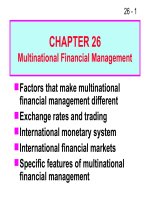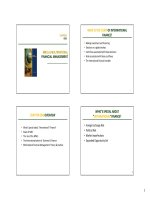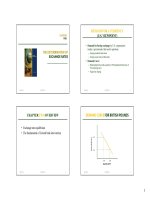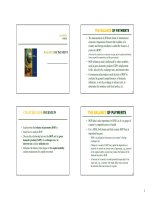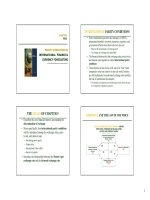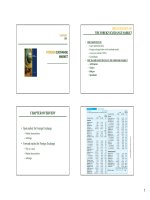FM11 Ch 26 Multinational Financial Management
Bạn đang xem bản rút gọn của tài liệu. Xem và tải ngay bản đầy đủ của tài liệu tại đây (107.28 KB, 42 trang )
26 - 1
Factors that make multinational
financial management different
Exchange rates and trading
International monetary system
International financial markets
Specific features of multinational
financial management
CHAPTER 26
Multinational Financial Management
26 - 2
What is a multinational corporation?
A multinational corporation is one
that operates in two or more
countries.
At one time, most multinationals
produced and sold in just a few
countries.
Today, many multinationals have
world-wide production and sales.
26 - 3
Why do firms expand into
other countries?
To seek new markets.
To seek new supplies of raw materials.
To gain new technologies.
To gain production efficiencies.
To avoid political and regulatory
obstacles.
To reduce risk by diversification.
26 - 4
What are the major factors that
distinguish multinational from
domestic financial management?
Currency differences
Economic and legal differences
Language differences
Cultural differences
Government roles
Political risk
26 - 5
Are these currency prices direct or
indirect quotations?
Since they are prices of foreign
currencies expressed in U.S. dollars,
they are direct quotations (dollars per
currency).
Consider the following exchange rates:
U.S. $ to buy
1 Unit
Euro 0.8000
Swedish krona 0.1000
26 - 6
What is an indirect quotation?
An indirect quotation gives the
amount of a foreign currency
required to buy one U.S. dollar
(currency per dollar).
Note than an indirect quotation is the
reciprocal of a direct quotation.
Euros and British pounds are
normally quoted as direct quotations.
All other currencies are quoted as
indirect.
26 - 7
Calculate the indirect quotations
for euros and kronas.
# of Units of Foreign
Currency per U.S. $
Euro 1.25
Swedish krona 10.00
Euro: 1 /
0.8000 = 1.25.
Krona: 1 /
0.1000 = 10.00.
26 - 8
What is a cross rate?
A cross rate is the exchange rate
between any two currencies not
involving U.S. dollars.
In practice, cross rates are usually
calculated from direct or indirect
rates. That is, on the basis of U.S.
dollar exchange rates.
26 - 9
Cross rate = x
= 1.25 x 0.1000
= 0.125 euros/krona.
Cross rate = x
= 10.00 x 0.8000
= 8.00 kronas/euro.
Calculate the two cross rates
between euros and kronas.
Euros Dollars
Dollar Krona
Kronas Dollars
Dollar Euros
26 - 10
The two cross rates are
reciprocals of one another.
They can be calculated by dividing
either the direct or indirect
quotations.
Note:
26 - 11
Target price = ($1.75)(1.50)=$2.625
Spanish price = ($2.625)(1.25 euros/$)
= € 3.28.
Assume the firm can produce a liter of
orange juice in the U.S. and ship it to
Spain for $1.75. If the firm wants a
50% markup on the product, what
should the juice sell for in Spain?
26 - 12
2.0 euros (8.0 kronas/euro) = 16 kronas.
20 - 16 = 4.0 kronas profit.
Dollar profit = 4.0 kronas(0.1000 dollars
per krona) = $0.40.
Now the firm begins producing the
orange juice in Spain. The product
costs 2.0 euros to produce and
ship to Sweden, where it can be sold
for 20 kronas. What is the dollar
profit on the sale?
26 - 13
Exchange rate risk is the risk that the
value of a cash flow in one currency
translated from another currency will
decline due to a change in exchange
rates.
What is exchange rate risk?
26 - 14
Currency Appreciation and
Depreciation
Suppose the exchange rate goes
from 10 kronas per dollar to 15
kronas per dollar.
A dollar now buys more kronas, so
the dollar is appreciating, or
strengthening.
The krona is depreciating, or
weakening.
26 - 15
Affect of Dollar Appreciation
Suppose the profit in kronas remains
unchanged at 4.0 kronas, but the
dollar appreciates, so the exchange
rate is now 15 kronas/dollar.
Dollar profit = 4.0 kronas / (15 kronas
per dollar) = $0.267.
Strengthening dollar hurts profits
from international sales.
26 - 16
The current system is a floating rate
system.
Prior to 1971, a fixed exchange rate
system was in effect.
The U.S. dollar was tied to gold.
Other currencies were tied to the
dollar.
Describe the current and former
international monetary systems.
26 - 17
The European Monetary Union
In 2002, the full implementation of the
“euro” was completed (those still
holding former currencies have 10
years to exchange them at a bank).
The newly formed European Central
Bank now controls the monetary
policy of the EMU.
26 - 18
The 12 Member Nations of the
European Monetary Union
Austria
Belgium
Finland
France
Germany
Ireland
Italy
Luxembourg
Netherlands
Portugal
Spain
Greece
26 - 19
A currency is convertible when the
issuing country promises to
redeem the currency at current
market rates.
Convertible currencies are traded in
world currency markets.
What is a convertible currency?
26 - 20
It becomes very difficult for multi-
national companies to conduct
business because there is no easy
way to take profits out of the country.
Often, firms will barter for goods to
export to their home countries.
What problems arise when a firm
operates in a country whose
currency is not convertible?
26 - 21
A spot rate is the rate applied to
buy currency for immediate
delivery.
A forward rate is the rate applied to
buy currency at some agreed-upon
future date.
Forward rates are normally
reported as indirect quotations.
What is the difference between
spot rates and forward rates?
26 - 22
When is the forward rate at a premium
to the spot rate?
If the U.S. dollar buys fewer units of a
foreign currency in the forward than in
the spot market, the foreign currency
is selling at a premium.
For example, suppose the spot rate is
0.7 £/$ and the forward rate is 0.6 £/$.
The dollar is expected to depreciate,
because it will buy fewer pounds.
Continued….
26 - 23
Spot rate = 0.7 £/$
Forward rate = 0.6 £/$.
The pound is expected to appreciate,
since it will buy more dollars in the
future.
So the forward rate for the pound is at
a premium.
26 - 24
When is the forward rate at a discount
to the spot rate?
If the U.S. dollar buys more units of a
foreign currency in the forward than in
the spot market, the foreign currency
is selling at a discount.
The primary determinant of the
spot/forward rate relationship is the
relationship between domestic and
foreign interest rates.
26 - 25
What is interest rate parity?
Interest rate parity implies that investors
should expect to earn the same return on
similar-risk securities in all countries:
Forward and spot rates are direct quotations.
r
h
= periodic interest rate in the home country.
r
f
= periodic interest rate in the foreign country.
Forward rate
Spot rate
=
1 + r
h
1 + r
f
.


